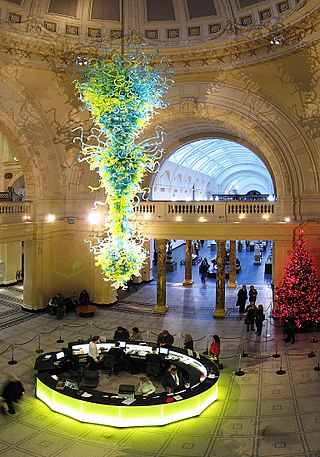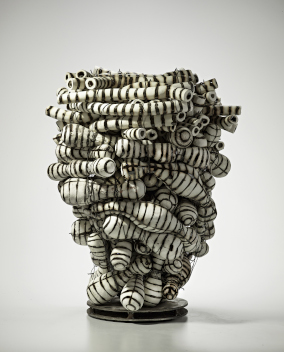Harvey Goldman | |
|---|---|
 | |
| Born | September 28, 1951 |
| Nationality | American |
| Occupation(s) | artist, educator, gardner |
| Known for | ceramics, digital art, experimental film and visual music |
Harvey Goldman (born September 28, 1951) is an American artist and educator.
Harvey Goldman | |
|---|---|
 | |
| Born | September 28, 1951 |
| Nationality | American |
| Occupation(s) | artist, educator, gardner |
| Known for | ceramics, digital art, experimental film and visual music |
Harvey Goldman (born September 28, 1951) is an American artist and educator.
He received a BFA from the University of Illinois at Urbana–Champaign and a MFA from the University of Massachusetts, Amherst.
Goldman is best known for his work in the fields of ceramics, digital art, experimental film and visual music. [1] [2] Goldman's work is represented among many private and public art collections including the IotaCenter for Experimental Animation, [3] Boston Museum of Fine Arts, [4] Everson Museum of Art, [5] DeCordova Museum and Sculpture Park]], [1] Currier Museum of Art, [1] and the Crocker Art Museum. [1] Goldman's work has been exhibited in a wide range of venues throughout the United States as well as Amsterdam, Austria, Australia, Britain, Canada, China, France, Germany, Israel, Italy, Japan, Spain, Romania, Russia, South Africa, and Turkey. [1] [6] He is the recipient of grants from the National Endowment for the Arts (Emerging Craftsman Award), [7] [8] The Ford Foundation and the Massachusetts Council on the Arts and Humanities. [9] Goldman taught at the University of Massachusetts, Dartmouth from 1978-2015.


Goldman's work in the area of ceramics ranges from approximately 1973–1987.The work is characterized by asymmetrical organic forms and rich multi-fired surfaces that reflect the effects of time and aging. His vessel "Wolley Zuff" was featured in Peter Lanes book Studio Ceramics [10] and on the cover of American Ceramics Magazine. [11] Goldman's ceramic work has been featured in many issues of Ceramics Monthly Magazine [12] He has taught ceramic workshops at both the Penland School of Crafts and the Haystack Mountain School of Crafts. Goldman's ceramic work has been acquired by both public and private collections including the Museum of American Ceramics, Pomona California.
Goldman's work in the area of ceramics ranges from approximately 1973–1987. The work is characterized by asymmetrical organic forms and rich multi-fired surfaces that reflect the effects of time and aging. His vessel "Wolley Zuff" was featured in Peter Lanes book Studio Ceramics [13] and on the cover of American Ceramics Magazine. [14] Goldman's ceramic work has been featured in many issues of Ceramics Monthly Magazine [15] He has taught ceramic workshops at both the Penland School of Crafts and the Haystack Mountain School of Crafts. Goldman's ceramic work has been acquired by both public and private collections including the Museum of American Ceramics, Pomona California.


Goldman's work in the area of digital imaging can be characterized by a rich use of the color, pattern and texture as well as a multi-layering of photographic elements. Art historian Dr. Thomas Stubblefield, has stated,"Utilizing digital photography to carefully layer graphic elements of the natural world, Goldman’s images blur the boundaries between still and moving images, painting and photography, realism and fantasy. These tensions form the basis of his Veiled Ancestors and Coincidentia Oppositorum series, a body of work that originates from the vast catalogue of photographs that the artist has collected from his daily walks in the woods. In this work the camera is called upon not to suspend or freeze time but to expand its reach, accumulating multiple moments within its frame" and "In his Extremities and Digits series, Goldman interrogates the inner workings of his primary tool, the hand. Despite never actually disclosing the artist himself, the work comprises a self-portrait of sorts. It is a meditation on the mystery of the creative process and the interconnectedness between the artist’s identity and his daily work." [16]

Goldman's work in the field of animation can be catalogued under the categories of experimental film and visual music. Goldman"s work have been displayed in film festivals worldwide, including, the Smithsonian's Hirshhorn Museum and Sculpture Garden, [17] [18] the Corcoran Gallery of Art [19] the White Box Museum, Beijing, China, [20] Kyoto Museum, Japan and MuVi4, [21] in conjunction with the Fifth International conference; Synaesthesia: Science and Art, Alcalà la Real, Jaèn, Spain. His animation "Sabinium" was created in collaboration with composer Ken Ueno. "Brahmanda", "Enigma" and "Passaddhi" have been created in collaboration with Chinese composer Jing Wang. [22]



References

Alfred University is a private university in Alfred, New York. It has a total undergraduate population of approximately 1,600 students. The university hosts the statutory New York State College of Ceramics, which includes The Inamori School of Engineering and the School of Art and Design.

American craft is craft work produced by independent studio artists working with traditional craft materials and processes. Examples include wood, glass, clay (ceramics), textiles, and metal (metalworking). Studio craft works tend to either serve or allude to a functional or utilitarian purpose, although they are just as often handled and exhibited in ways similar to visual art objects.
D. Wayne Higby is an American artist working in ceramics. The American Craft Museum considers him a "visionary of the American Crafts Movement" and recognized him as one of seven artists who are "genuine living legends representing the best of American artists in their chosen medium."

Rudolf Harry "Rudi" Staffel was an American ceramic artist and educator.
Alice R. Ballard is an American ceramicist based in Clover, South Carolina. Much of her work is characterized by the organic earthenware forms of closed containers, pinch pots, platters, pods, teapots, totems, small work, vessels and a series she refers to as her white work. Much of her work is finished with terra sigillata. Alice considers her art to be “a reflection of [her] relationship with natural forms. It is often the metamorphosis of Nature's forms, as they change from season to season, that attracts her to that universal world in which differing life forms share similar qualities." Her aesthetic heavily references the mother/child/germination metaphor and also explores the more evocative realm of wonder and awe.

Annabeth Rosen is an American sculptor best known for abstract ceramic works, as well as drawings. She is considered part of a second generation of Bay Area ceramic artists after the California Clay Movement, who have challenged ceramic traditions involving expression, form and function and helped spur the medium's acceptance in mainstream contemporary sculpture. Rosen's sculptures range from monumental to tabletop-sized, and emerge out of an accumulative bricolage process combining dozens or hundreds of fabricated parts and clay fragments and discards. Reviewers characterize her art as deliberately raw, both muscular and unapologetic feminine, and highly abstract yet widely referential in its suggestions of humanoid, botanical, aquatic, artificial, even science-fictional qualities. Critic Kay Whitney wrote that her work is "visceral in its impact, violent even, but also sensual and evocative" and "floats between the poles of the comic and the mordant."
Norm Schulman was an American ceramic artist who lived in Penland, North Carolina. He was born in New York City in 1924. He operated his own studio, Norman Schulman Studio, in Penland.
Cristina Córdova is an American-born, Puerto Rican sculptor who works and lives in Penland, North Carolina.
Jack Doherty is a Northern Irish studio potter and author. He is perhaps best known for his vessels made of soda-fired porcelain. He has been featured in a number of books, and his work has been exhibited widely in both Europe and North America. Articles of his have appeared in various pottery journals and he has been Chair of the Craft Potters Association.
Beth Lo in Lafayette, Indiana is an American artist, ceramist and educator. Her parents emigrated from China.
Kirk Mangus (1952–2013) was an internationally renowned ceramic artist and sculptor "known for his playful, gestural style, roughhewn forms, and experimental glazing". His murals, works in clay, on paper, in wood, and other media pull from a rich and diverse set of influences: ancient Greco-Roman art, mythology, Japanese woodblock prints, comic books, folk stories, from Meso-American through Middle-Eastern and Asian ceramic traditions as well as the people he saw, the places he travelled, and his own dreamworld. He loved experimenting with new mediums, local materials, clay bodies, slips, kiln-building and the firing process.

Harrison Edward McIntosh was an American ceramic artist. He was an exponent of the Mid-century Modern style of ceramics, featuring simple symmetrical forms. His work has been exhibited in venues in the United States including the Smithsonian and internationally including at the Louvre in France.

Ayumi Horie is a Portland, Maine-based studio potter. She is recognized for her unique aesthetic as well as for her pioneering use of digital marketing and social media within contemporary ceramics. She is curator of the popular Instagram feed Pots in Action and is a 2015 United States Artist Distinguished Fellow in Craft.
Winnie Owens-Hart is an American ceramist and sculptor.
Richard Shaw is an American ceramicist and professor known for his trompe-l'œil style. A term often associated with paintings, referring to the illusion that a two-dimensional surface is three-dimensional. In Shaw's work, it refers to his replication of everyday objects in porcelain. He then glazes these components and groups them in unexpected and even jarring combinations. Interested in how objects can reflect a person or identity, Shaw poses questions regarding the relationship between appearances and reality.
Chris Gustin is an American ceramicist. Gustin models his work on the human form, which is shown through the shape, color, and size of the pieces.

Nancy Selvin is an American sculptor, recognized for ceramic works and tableaux that explore the vessel form and balance an interplay of materials, minimal forms, and expressive processes. She emerged in the late 1960s among a "second generation" of Bay Area ceramic artists who followed the California Clay Movement and continued to challenge ceramic traditions involving expression, form and function, and an art-world that placed the medium outside its established hierarchy. Her work has been exhibited at the Los Angeles County Museum of Art (LACMA), Denver Art Museum, Daum Museum of Contemporary Art and Kohler Arts Center, and belongs to the public art collections of LACMA, the Smithsonian Institution, Oakland Museum of California, and Crocker Art Museum, among others. Critic David Roth has written, "Selvin's position in the top rank of ceramic artists has come through a process of rigorous self-examination … what differentiates [her] is that she eschews realism and functionality, indicating a level of intellectual engagement not always found among ceramicists." Writer and curator Jo Lauria described Selvin's tableaux as "elegiac and stylistically unified" works that serve as "forceful essays on the relationship between realism and abstraction, object and subject, decoration and use." Selvin lives and works in the Berkeley, California area.
Lisa Kay Orr is an American potter and a teacher of ceramics. Orr has work in both public and private collections, and shows her work nationally as well as internationally. Orr's work can be seen in the Fine Arts Museum of San Francisco and in Korea in the collection of the WOCEF.
Cynthia Bringle was born in Memphis, Tennessee, and has lived and worked in Penland, North Carolina since 1970. She is a potter and teaches at the Penland School of Crafts, Anderson Ranch Arts Center, and John C. Campbell Folk School.

Sana Musasama is an African-American ceramic and mixed-media artist based in New York City. Her artistic practice parallels her work as an educator and commitment to human rights causes especially the human trafficking of women. Her work has been recognized with numerous awards including an Anonymous Was a Woman Award in 2002, Joan Mitchell Painters and Sculptors Grant in 2013, and was a Studio Museum in Harlem Artist-in-Residence in 1983–84. Musasama is an associate adjunct professor at Hunter College.